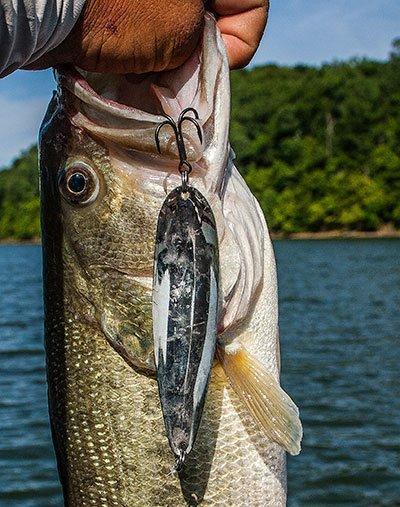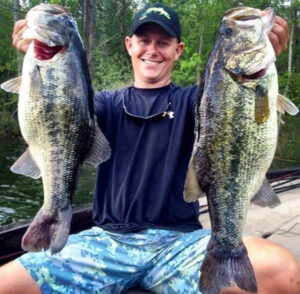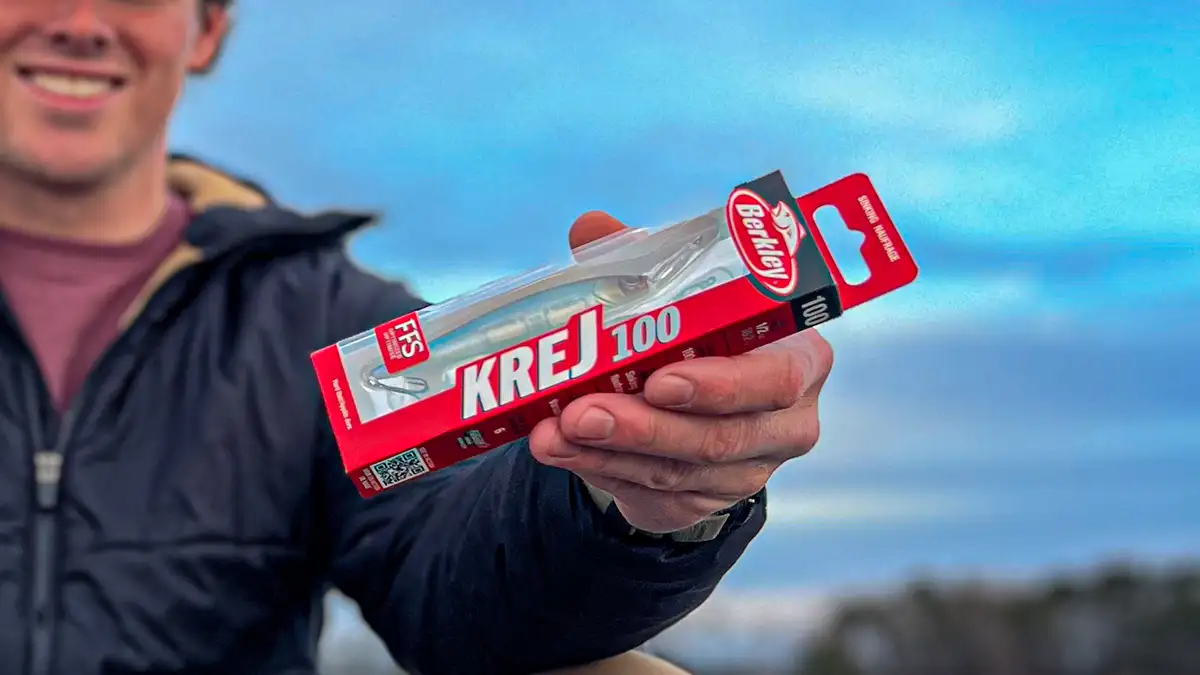When most of us think about fishing big flutter spoons, visions of deep water, offshore structure and dramatic jerks of the rod come to mind. We’ve recently caught wind of a totally different approach to big spoon fishing, however. Speed cranking big spoons in shallow water is proving to be an excellent way to catch giant bass throughout the summer months.
Lew’s pro Andrew Upshaw discovered this technique on his home lake of Toledo Bend and has since been using it to his advantage on lakes across the country. Having recently caught several bass in excess of 10 pounds with this technique, Upshaw lets other anglers fight over the deep schools of bass, allowing him to use the shallow water all for himself.
Why go shallow with a big spoon?
This big bass barely got the spoon and we were still able to land it with a straight wind to the boat.
It’s no secret that summer bass assemble into offshore “mega-schools”. Upshaw, however, has found that the biggest bass often break away from these big schools, making them especially susceptible to this underutilized technique.
“These schools get pressured by anglers constantly and big bass are smart—they don’t want any part of it,” Upshaw said. “I’m convinced that the true giants seek refuge in shallower water because they know they won’t get bothered as much.”
Upshaw also believes the bass’ summertime feeding behavior is a big reason for his recent success with speed cranking big spoons. As the water temperatures cool overnight, otherwise inactive bass often flock to shallow water to gorge themselves before heading back to their deep dwellings.
“Summer bass are notorious for feeding at night,” Upshaw said. “That’s why the fishing can be so tough this time of year. You can intercept these aggressive bass in lowlight hours and take advantage of them coming to and leaving these productive shallow feeding grounds.”
How to speed crank a big spoon
While many bass fishing techniques are intricate and require almost pinpoint precision, that’s not necessarily the case with this technique. Upshaw looks to imitate big shad or small yellow bass, but it’s a fairly simple presentation to master.
“I cast as far as I can, let the spoon fall to the bottom and hold my rod at the 10 o’clock position,” Upshaw said. “Then I’ll reel it as fast as I can for about 3 cranks and let it fall back down on a tight line while keeping the rod at 10 o’clock. The weight of the spoon causes it to glide to the bottom with its nose pointed downward, which looks just like bait swimming off the bottom.”
Upshaw heavily stresses the importance of letting the spoon fall on a tight line. Not only does it give it an enticing action, but it gives him enough leverage for a quick hookset.
“A lot of times a bite will just feel heavy or your rod will load up,” Upshaw said. “You also have to watch for any twitches or jumps in your line. When this happens, you’ve got to get a hook in them quickly, so a tight line is essential.”
Find sandy flats near deep water for giant bas
Because big bass often “go rogue” from summertime mega-schools, Upshaw starts by locating these schools on his Lowrance. When he runs across a huge school of bass, he looks for nearby flats in shallow water
“You’ll see a lot of folks focusing on the points of flats, but this technique works best when you concentrate on the cuts between two points on a flat,” Upshaw said. “These cuts act as drains, giving big bass easy access to and from these flats.”
It’s important to understand that “shallow” is a relative term when talking about speed cranking big flutter spoons. Although he’s caught several 10-pounders in as little as 6 feet of water with this technique, the majority of Upshaw’s success comes in the 15-foot range.
“These rogue bass don’t wander far from the mega-schools,” Upshaw said. “Many times you can find them in shallow water just 75 yards away from the school. For whatever reason, I don’t catch many big ones with this technique in water deeper than 16 feet. If you can find sandy flats in 6 to 15 feet of water, you’re liable to get your arm broken.”
Big flutter spoons aren’t exactly renowned for being weedless, so Upshaw actually looks for flats void of cover. It hasn’t hurt his success because it’s not the cover the big ones are concerned with—it’s all about the bait.
Speed cranking big spoons on sandy flats in 6 to 15 feet of water can lead to giant bass in the summertime.
Using the correct gear is very important
Upshaw exclusively uses a Talon Custom Lures Lake Fork Flutter Spoon for this technique, in either 1 1/4-ounce or 1 1/2-ounce size depending on water depth. While many anglers are big believers in color selection, he prefers to keep it simple.
“Here in Texas, the giant bass most often feed on small yellow bass, so I like to use the Barfish color to emulate them,” Upshaw said. “If I’m fishing in an area with a lot of big shad or gizzard shad, I really like the Chrome Holo Silver color.”
Although he uses a huge spoon for this technique, Upshaw actually prefers a 7-foot, 6-inch medium-heavy Lew’s Team Casting Rod. Its backbone handles huge bass very well while its tip provides him with the necessary “give” to ensure a good hookset.
“You’ve got to have a little bit of tip when speed cranking,” Upshaw said. “If you reel into one while speed cranking, a rod that’s too heavy will rip the hook out. This lets you set the hook a lot harder without pulling it away from the fish.”
According to Upshaw, fluorocarbon line is a big “no-no” with this technique. Instead, he prefers 20-pound Izorline XXX Super Copolymer for more stretch and for better hookups. A strong line is important when horsing big bass to the boat.
4 quick tips to increase your success
Upshaw has been using this technique for quite some time and has developed some simple tips that have helped him catch more big bass.
- Line twist is inevitable and a swivel will impede the action. Keep a bottle of Kevin VanDam’s Line and Lure Conditioner nearby and apply liberally 3 to 4 times throughout the day to minimize backlashes. Retying often is also important.
- “Worm” the big spoon back to the boat when you get short strikes—they’ll almost always come back a second time.
- Bass throw big spoons easily, so it’s important to horse them to the boat as quickly as possible to increase your hookup ratio. Never play the fish slowly. A 7.1:1 Lew’s BB-1 Speed Spool Casting Reel with a cinched-down drag is perfect for this application.
- Don’t use a stinger hook. Although acceptable for deep presentations, they will cause more hang-ups when speed cranking.
Next time you hit the water this summer, try speed cranking a big spoon. It’s not necessarily a “quantity” technique, but it’s a great way to put huge bass in the boat.














